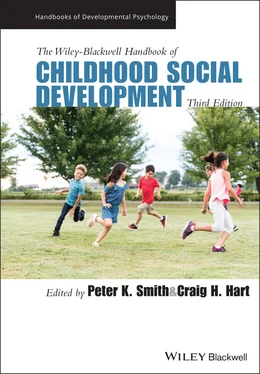Other work which has tried to bridge the disciplinary gap, and which has drawn heavily on anthropological studies, has come from recent work on psychology and children’s rights. This acknowledges the intellectual problems that psychologists have struggled with over the concept of children’s rights (struggles that have been shared with anthropologists, see Montgomery, 2017) such as whether principles such as morality, dignity, equality, or respect are Western‐based philosophical notions which have limited meaning outside the West; whether any human is really truly rational (or a mass of instincts springing from evolutionary processes); or whether children are largely the subjects of socialization or active agents. Recent work on rural and urban Chinese children’s view of rights, for example, and their relationship to development, socialization and well‐being (Helwig & Turiel, 2017) has successfully synthesized ethnographic accounts of socialization from the American tradition, understandings of children’s agency and their importance as informants from the New Social Studies of Childhood, and psychological theories of moral socialization. In such work, social development and cultural processes are seen through the lens of children’s perspectives rather than adult socialization practices, and are overlaid with questions about universality and cultural relativism. While neither anthropologists nor psychologists can answer these definitively the fact that they are asking the same questions and drawing on the learning and experiences of the other discipline is grounds for hope for future dialogue.
The relationship between anthropology and social development is a complex one; at times, and in some traditions, mutually enhancing, at different times and in different traditions, mutually suspicious, even hostile. Yet despite this, there are large areas of overlap and anthropologists, whatever their background, with their emphasis on the collection and analysis of detailed ethnographic data, have undoubtedly made significant contributions to studies of all aspects of children’s development. As psychologists incorporate genuinely contextual and cultural approaches in their models of childhood, important new insights are adding to a fuller understanding of children and young people’s experiences and responses to them. These are further expanded as psychologists begin not just to talk to children and young people, but also to listen and to hear them, understanding them not only as future adults but also as people in the present, seeking to identify their meanings and interpretations of their worlds and using these to inform research. At the same time, anthropologists have begun to recognize the need to learn from psychology and to apply their knowledge and theories to studies of children’s social development. It is to be hoped that, in future, there can be greater dialogue and that studies of social development become multidisciplinary projects, characterized by different ways of looking at and understanding children which, while they differ in epistemological and methodological background, nevertheless contribute equally to more holistic studies of childhood and children’s lives.
1 Alanen, L. (2015). Are we all constructionists now? Childhood, 22(2), 149–153.
2 Boas, F. (1916). New evidence in regard to the instability of human types. Proceedings of the National Academy of Sciences, 2(12), 713–718.
3 Boyden, J. (1997). Childhood and the policy makers: A comparative perspective on the globalization of childhood. In A. James and A. Prout (Eds.), Constructing and reconstructing childhood: Contemporary issues in the sociological study of childhood (pp. 190–209). Falmer Press.
4 Bronfenbrenner, U. (1979). The ecology of human development: Experiments by nature and design. Harvard University Press.
5 Burman, E. (1996). Local, global and globalized: Child development and international child rights legislation. Childhood, 3(1), 45–66.
6 Burr, R. (2004). Children’s rights: International policy and lived practice. In M. J. Kehily (Ed.), An introduction to childhood studies (pp. 145–159). Open University Press.
7 Chen, X., & Eisenberg, N. (2012). Understanding cultural issues in child development: Introduction. Child Development Perspectives, 6(1), 1–4.
8 Evans‐Pritchard, E. E. (1965). The comparative method in social anthropology. In E. E. Evans‐Pritchard (Ed.), The position of women in primitive societies: And other essays in social anthropology (pp. 13–36). Faber and Faber.
9 Freeman, D. (1983). Margaret Mead and Samoa: The making and unmaking of an anthropological myth. Harvard University Press.
10 Goody, J., & Goody, E. (1967). The circulation of women and children in northern Ghana. Man (N.S.), 2(2), 226–248.
11 Gullestad, M. (1984). Kitchen table society: A case study of the family life and friendships of young working‐class mothers in urban Norway. Universitetsforlaget.
12 Hardman, C. (1973). Can there be an anthropology of children? Journal of the Anthropology Society Oxford, 4(1), 85–99.
13 Harkness, S. (2002). Culture and social development: Explanations and evidence. In P. K. Smith & C. H. Hart (Eds.), Wiley‐Blackwell handbook of childhood social development (pp. 60–77). Blackwell.
14 Helwig, C. & Turiel, E. (2017). The psychology of children’s rights. In M. Ruck, M. Peterson‐Badali, & M. Freeman (Eds.), Children’s rights: Global and multidisciplinary perspectives (pp. 132–148). Taylor and Francis.
15 Hewlett, B. S., & Lamb, M. E. (2005). Emerging issues in the study of hunter‐gatherer children. In B. S. Hewlett & M. E. Lamb (Eds.), Hunter gatherer childhoods: Evolutionary, developmental, and cultural perspectives (pp. 3–18). Transaction/Aldine.
16 James, A. (1993). Childhood identities: Self and social relationship in the experience of the child. Edinburgh University Press.
17 James, A., & Prout, A. (Eds.). (1997). Constructing and reconstructing childhood: Contemporary issues in the sociological study of childhood. Falmer Press.
18 James, A., Jenks, C., & Prout, A. (1998). Theorizing childhood. Polity Press.
19 Konner, M. (2011). The evolution of childhood: Relationships, emotion, mind. Harvard University Press.
20 La Fontaine, J. S. (1986). An anthropological perspective on children in social worlds. In M. Richards & P. Light (Eds.), Children of social worlds (pp. 10–30). Polity Press.
21 Lancy, D. (1977). The play behavior of Kpelle children during rapid cultural change. In D. Lancy & B. A. Tindall (Eds.), The anthropological study of play: Problems and perspectives (pp. 72–79). Leisure Press.
22 Lancy, D. (2012). The chore curriculum. In G. Spittler & M. Bourdillon (Eds.), African children at work: Working and learning in growing up for life (pp. 23–56). LIT Verlag.
23 Lancy, D. (2014). The anthropology of childhood: Cherubs, chattel, changelings (2nd ed.). Cambridge University Press.
24 Lancy, D., Bock, J. C., & Gaskins, S. (Eds.). (2010). The anthropology of learning in childhood. AltaMira.
25 Leach, E. (1964). Response to Raoul Naroll’s “On ethnic unit classification.” Current Anthropology, 5(4), 299.
26 LeVine, R. (1977). Child rearing as cultural adaptation. In P. H. Leiderman, S. Tulkin, & A. Rosenfeld (Eds.), Culture and infancy: Variations in the human experience (pp. 15–27). Academic Press.
27 LeVine, R. (2003). Childhood socialization: Comparative studies of parenting, learning and educational change. Comparative Education Research Centre.
28 LeVine, R. (2007). Ethnographic studies of childhood: A historical overview. American Anthropologist, 109(2), 247–260.
29 LeVine, R., & New, R. (Eds.). (2008). Anthropology and child development: A cross‐cultural reader. Blackwell.
Читать дальше












